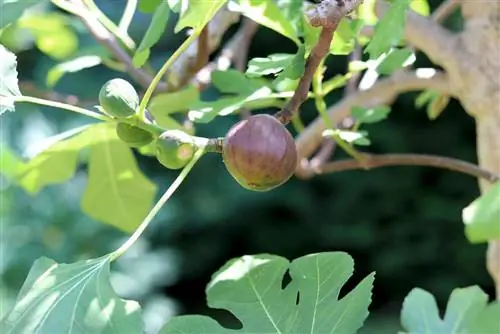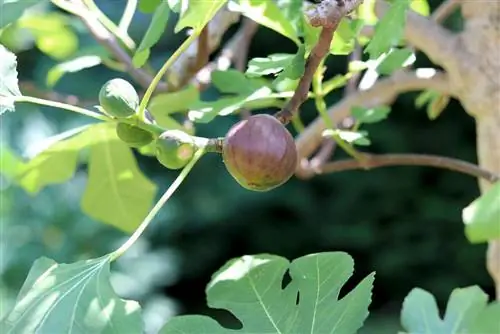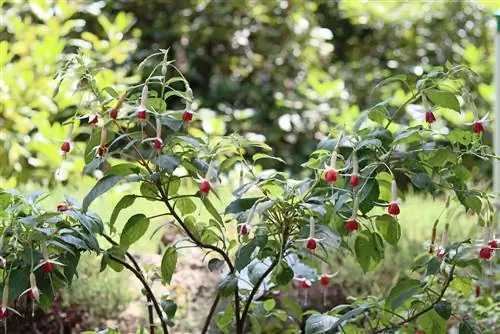- Author admin [email protected].
- Public 2023-12-17 03:39.
- Last modified 2025-01-24 12:45.
Fresh figs in autumn or even dried ones in the winter months are a pleasure. This is why the fig tree is becoming increasingly popular in these latitudes. But it doesn't necessarily have to be cultivated in the garden; the tree is also suitable for planting in containers. A cellar, a garage or a place in the living room can then be chosen for overwintering. But fig trees can also be kept outdoors over the winter with a few tips.
Overwintering the figs
Figs are only partially hardy and therefore need to be protected more or less in winter, especially if they have not yet reached their tenth birthday. This depends primarily on the cultivation, the variety of the fig and the climatic zone in which the tree is located. The different varieties of fig trees are slightly hardy down to -20° Celsius. Therefore, when purchasing, you should definitely ask how your own fig tree is doing. If the variety is frost hardy, it can certainly be cultivated in the garden, especially in a mild climate. All other fig trees are kept safe in a pot that can be moved to a frost-free place in winter.
Right time
The fig tree should always be protected from frost from October to March. If a frost strike occurs in autumn, the branches and twigs could suffer frost damage and then inevitably have to be removed. It is therefore advisable to protect the trees before the first expected frost nights in November. Frosty nights can still be expected in March and April and into May after the Ice Saints. Here, too, the figs should be covered with plant fleece on cold nights so that the young, newly sprouting leaves are not damaged. During the day, however, the trees can stand unprotected outdoors.
House corner
A good location for summer and winter is in the corner of the house in a garden bed. Here the fig trees can also be protected from the wind in summer and protected against frost in winter. When overwintering, you should proceed as follows:
- Place brushwood or mulch on the soil
- wrap the tree with plant fleece
- wait until the tree has lost all its leaves
- Plant fleece can be attached to the house wall
- so the air can circulate better
- Do not fertilize from September/October
- continue watering during dry periods in winter
- only water on frost-free days
- Ideally with slightly warm water
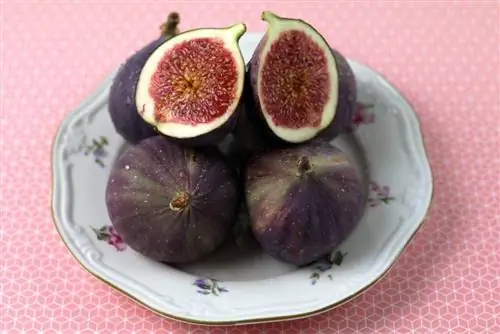
If the days slowly become longer and warmer in March, the plant fleece can be removed. However, it should remain available in case very cold nights with lots of frost are expected. Fertilization can now begin again. However, mulch and brushwood should still remain on the soil. At midday the tree should not be exposed to the blazing sun, otherwise the young leaves will burn.
Tip:
If a tree is planted in a corner of the house, care should be taken to ensure that figs in the garden bed can reach an impressive size of up to three meters.
On the terrace or balcony
If the fig tree was cultivated in a bucket, then there is the option of overwintering on a covered balcony or covered terrace. To do this, the pot is pushed into a protected corner and placed on a Styrofoam plate or wooden plates. This means that no cold gets into the pot from below. The bucket itself is wrapped all around with plant fleece. However, brushwood mats have a more decorative effect here. Otherwise, when overwintering on the terrace or balcony, proceed as follows:
- also wrap the tree itself with plant fleece
- Mulch can be added to the soil
- water lightly on frost-free days
- stop fertilizing between September and October
- Remove the plant fleece during the day from March
- However, continue to protect the tree on cold nights
- Start fertilizing again in March
- do not expose the delicate leaves to direct midday sun
Tip:
A fig in winter quarters or protected under a plant fleece should be checked regularly for spider mites, which tend to attack the tree in winter.
Garage, basement
Since figs are deciduous trees, they can also be overwintered in a dark place. Therefore, the basement or garage are ideal for overwintering in a bucket. However, the basement must be cool, so a boiler room as a winter location is not recommended. Fertilizer should also be stopped in September/October for figs that are overwintered in the cellar or garage. Please note the following when wintering:
- keep slightly moist over the winter
- Avoid waterlogging
- don't let it dry out
- Slowly get used to warmth and brightness in March
- place outside in a protected place
- protect on frosty nights
- start fertilizing
Tip:
If the fig is taken out of its quarters after the winter, the best time to repot the plant is before the first fertilization.
Apartment
If there is no basement, garage, terrace or balcony available for overwintering, then the fig can also be overwintered in the apartment. However, the warm living room is not recommended for this. The plant is also not very decorative in winter because it loses all of its leaves in autumn. Therefore, overwintering in the apartment is only recommended to a limited extent:
- choose a cool room
- Guest rooms or bedrooms are ideal
- Hallway or stairwell as well
- there's no other way, don't put it right next to the heater
- keep moist and avoid waterlogging
- do not fertilize over the winter
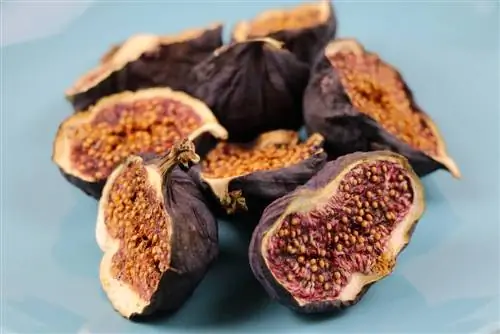
From March onwards, the fig will be taken outside to a protected place and fertilized again. However, direct sunlight should be avoided in the first few months, especially around midday.
Tip:
Even if the fig is not hardy at all or only partially hardy, it still wants cool temperatures during its rest periods, ideally between 0° and 12° Celsius.
Winter Garden
If an unheated winter garden is available, then this is the ideal place to overwinter the fig. If the winter garden is also large enough and offers enough light and air in summer, then it is well suited for cultivating the tree all year round. Overwintering the fig in the winter garden should be as follows:
- Put the container inside in the fall
- Set fertilizer
- keep moderately moist
- Avoid waterlogging
- slowly getting used to the warmth in March
- A winter garden is usually bright
- Start fertilization again
Tip:
In a bright, frost-free and not too warm winter quarter, you can continue to fertilize moderately over the winter months, then the new leaves will form more quickly in spring. But this is just an option and not a must.
Freeland
Depending on the variety, a fig tree can also spend the winter outdoors without needing to be protected. As a rule, in such a case only the ground is covered with brushwood or mulch to keep out frost and keep the ground moist. Fertilization will also stop in the fall. Watering is only carried out on frost-free days during longer dry periods. But the young fig trees, even if they are a frost-hardy variety, also need to be protected in winter for up to ten years. You should proceed as follows:
- cover the entire tree with plant fleece
- wait for the leaves to drop completely
- otherwise there could be rot under the fleece
- mold could also form
- alternatively, a frame can be built from wooden slats and fleece
- this is simply placed over the tree
- from March the fig will be freed from the fleece again
- we are now fertilizing again
If there are further frosty nights ahead, the tree should be protected again overnight so that the young leaves do not freeze.

